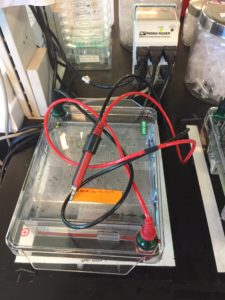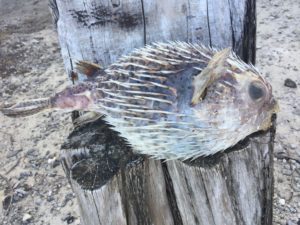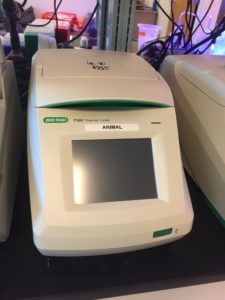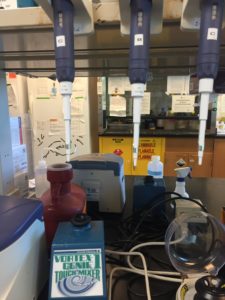Hello! My name is Georgia Pieper and I am doing my Pinhead Internship at the Hawai’i Institute of Marine Biology on Coconut Island. Coconut Island, also known as Moku o Loe, is about 28 acres all together off the windward coast of Oahu. During my first day on Moku o Loe, Professor Rob Toonen gave me a tour of the the different lab facilities on the island including some coral wet labs and a shark enclosure consisting of four Hammerheads and one Sandbar shark. During my time at HIMB, I will mainly be working with Professor Rob Toonen and postdoc Mariana Souza.
This first week at Coconut I have mainly spent working in the ToBo lab with friends Leah Shizuru and Anne lee. Leah and Anne have been very kind and allowed me to help them with their Masters work, as we have been unable to set up our coral experiment just yet. This experiment will test how corals respond to different variations of flow in controlled tanks and will begin next week. My experience in the lab has been amazing because I am very interested in microbiology and genetics, which are both closely correlated with the work of marine biologists.
We performed DNA extractions for both fish and coral. Leah is working with a species of black coral and Anne is doing her research on soldier fish. Doing these DNA extractions involved lots of pi-petting; a skill that I have yet to develop fully. We added the fish and coral samples to a specific buffer which breaks down certain proteins and then we left them to incubate. We then performed a polymerase chain reaction (PCR) which is a method to make many copies of a DNA segment. With PCR, copies of DNA sequences are amplified to in turn generate thousands of more copies of that DNA segment. To do this we used a thermocycler which is a lab apparatus and takes a while to complete. We also used the technique of Gel Electrophoresis to seperate DNA fragments by size and charge. To do this we made a gel with wells from a mold. We then loaded DNA samples into the wells at one end of the gel, where an electric current is applied the pull them through the gel. DNA fragments are negatively charged, so they move towards the positive electrode. All the DNA fragments have the same amount of charge per mass so small fragments move through the gel faster than larger ones. When a gel is stained with a DNA binding dye, the DNA fragments are seen as bands representing a group of DNA fragments. These bands are used to show which DNA samples are worthwhile and then sent to be sequenced at another lab off the island.
There are many amazing marine organisms to see in this area. On my first week I was very fortunate and was able to see a sandbar shark during a snorkel and a decaying puffer fish that washed up to shore close to our dorms. One night we traveled to Honolulu by bus for First Friday and went to a restaurant called Opal Thai. This experience was also amazing because they do not have menus but rather the owner asks everyone to name five Thai dishes and then asks some other questions and then makes several different dishes for each table. I would highly recommend this restaurant to anyone who enjoys Thai food. This has been a great week and I can’t wait to dive into another week of adventures.





Awesome post, Georgia! How cool that you will be doing your Pintership on Coconut Island. We can’t wait to hear how your coral experiments unfold!